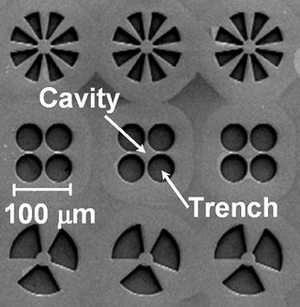December 12, 2007 feature
Scientists make single-photon sources brighter

Scientists have achieved a major advance in developing a single-photon light source, bringing quantum applications such as quantum computing and quantum cryptography closer to reality.
A research team at the University of California at Santa Barbara (UCSB), headed by Prof. Dirk Bouwmeester (Physics), Prof. Pierre Petroff (Materials and ECE) and Prof. Larry Coldren (ECE), has created a robust micron-sized semiconductor device that can emit single photons on demand at a rate of 31 million photons per second (31 MHz) into an optical fiber, five times better than previously possible.
The scientists’ study makes the cover of the Nature Photonics December issue. In the publication, the researchers describe how they developed a single-photon source based on a semiconductor quantum dot that is structurally robust and provides record-high light extraction efficiencies up to 38%. Several innovations contributed to the higher performance, including a new microcavity design, embedded oxide apertures, and electrical gates to control the emission rate of the active quantum dot material.
“Combining all these tricks in a properly designed semiconductor device enabled us to measure five million single photons per second, corresponding to a net single-photon generation rate of 31 MHz,” Stefan Strauf, Assistant Professor at the Stevens Institute of Technology in New Jersey, told PhysOrg.com. “Furthermore, we have recorded single-photon signatures at rates up to 116 MHz, but only under continuous, rather than pulsed, laser excitation due to technical limitations, where the ‘on-demand’ character is lost. Nevertheless, these experiments demonstrate the potential for further improvements of the devices.”
The researchers’ design was built on a common technique for generating single photons: using an optical microcavity to harvest the light emitted by an individual quantum dot. When light is squeezed into a small space around a quantum dot with the help of an optical cavity, the electrical carriers inside the quantum dot are forced to emit light more rapidly. To confine the light very strongly, microcavities with very precise geometries are necessary. In the past, scientists have etched tiny micropillars with sub-micrometer dimensions to confine the light, but the downside is that the etching causes rough sidewalls that scatter the light away.
Instead of etching tiny micropillars, the scientists etched large trenches leaving cavities with diameters of about 20 microns, and used embedded aluminum-oxide apertures to confine the light field into a tiny space, successfully avoiding scattering losses. It turned out that the aperture design is also mechanically stronger than the brittle pillars, enabling the scientists to attach electrical contacts to control the emission of the quantum dots (due to the Purcell effect), and further improving the photon generation rate.
The new design also opened possibilities to explore geometries of the etched trenches forming the cavity (see the cover illustration of Nature Photonics). This geometry also influences the shape of the confined light field inside the cavity and thus dictates the polarization of the emitted light field. With the help of the electrical contacts, the researchers demonstrated voltage control of the single photon polarization. This ability is important for quantum cryptography, enabling the zeros and ones of the binary code to be encoded in the photons’ polarization.
One of the next improvements was the scientists’ ability to prohibit “dark states” from forming, something which has never been achieved before. When an electron and a hole are captured by a quantum dot, they form excitons that have a spin of either one or two. As the scientists explained, a spin of one allows the exciton to couple to the optical field and recombine, but an exciton with a spin of two cannot fire, and forms a “dark state.”
“You want to avoid these so-called dark states from forming,” Strauf explained. “And you can do this by preloading the quantum dots with a single electron. This way, after the capture of an electron-hole pair, there are two electrons, which must have opposite spin owing to the Pauli principle. This means that the electron always finds a bright recombination path.”
The new single-photon source marks a significant step toward a practical device, in an area where progress has been rapid. As Strauf notes, just five years ago it took eight hours to record a decent single-photon signature from a semiconductor. Compare that with the current timescale of milliseconds to record a single-photon signature, and the odds are high that single-photon sources will continue to improve. Ultimately, the rate of single-photon generation is limited by the lifetime of the dot’s excited state – about 0.1 to 1 nanosecond, which corresponds to a 1 to 10 GHZ range. These rates are yet to be seen, however.
Besides achieving a high generation rate, quantum applications will also require other improvements. Currently, UCSB’s single-photon sources operate at 950-nanometer wavelengths and at cryogenic temperatures, but practical quantum cryptography will require telecommunication wavelengths and operation at room temperature. Nevertheless, the researchers are hopeful that single-photon sources will one day provide the technology for many interesting applications.
More information: Strauf, Stefan, Stoltz, Nick G., Rakher, Matthew T., Coldren, Larry A., Petroff, Pierre M., and Bouwmeester, Dirk. “High-frequency single-photon source with polarization control.” Nature Photonics, Vol. 1, December 2007, 704-708.
Copyright 2007 PhysOrg.com.
All rights reserved. This material may not be published, broadcast, rewritten or redistributed in whole or part without the express written permission of PhysOrg.com.





















